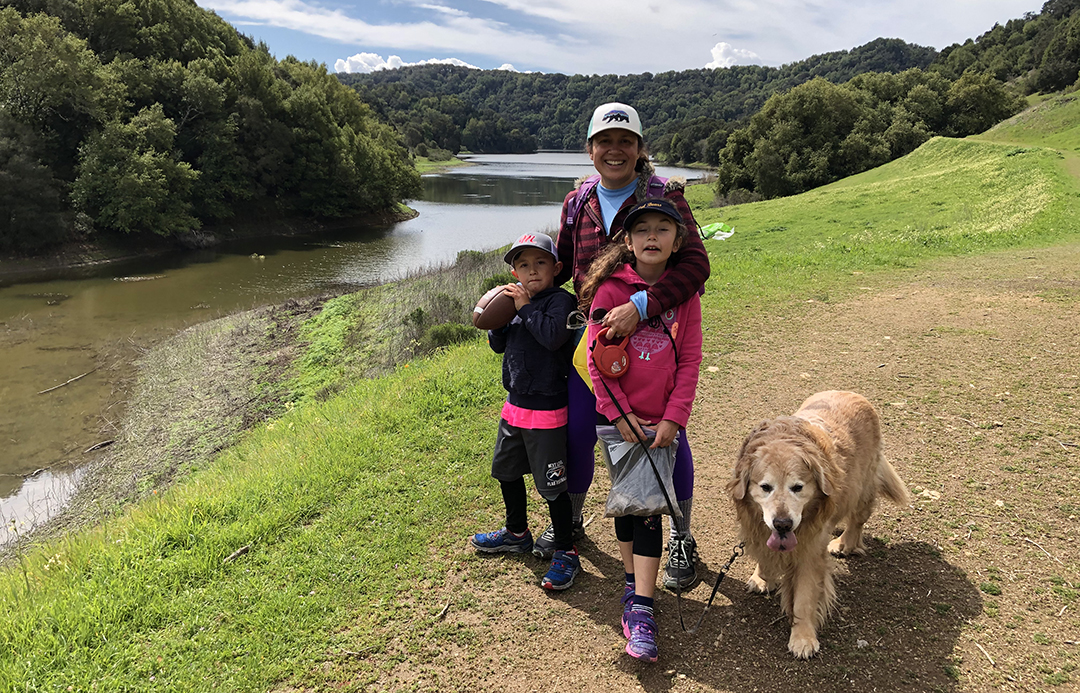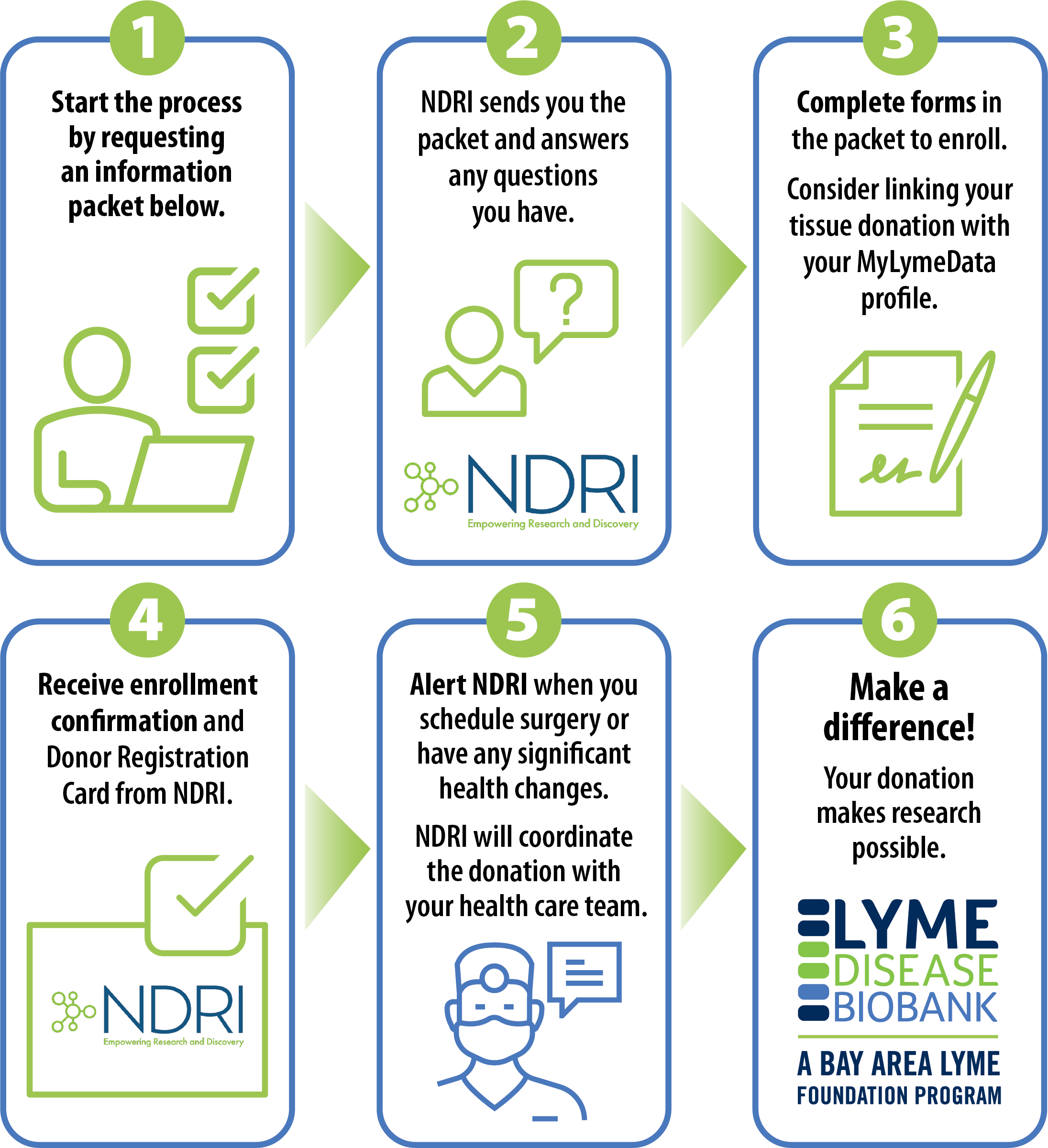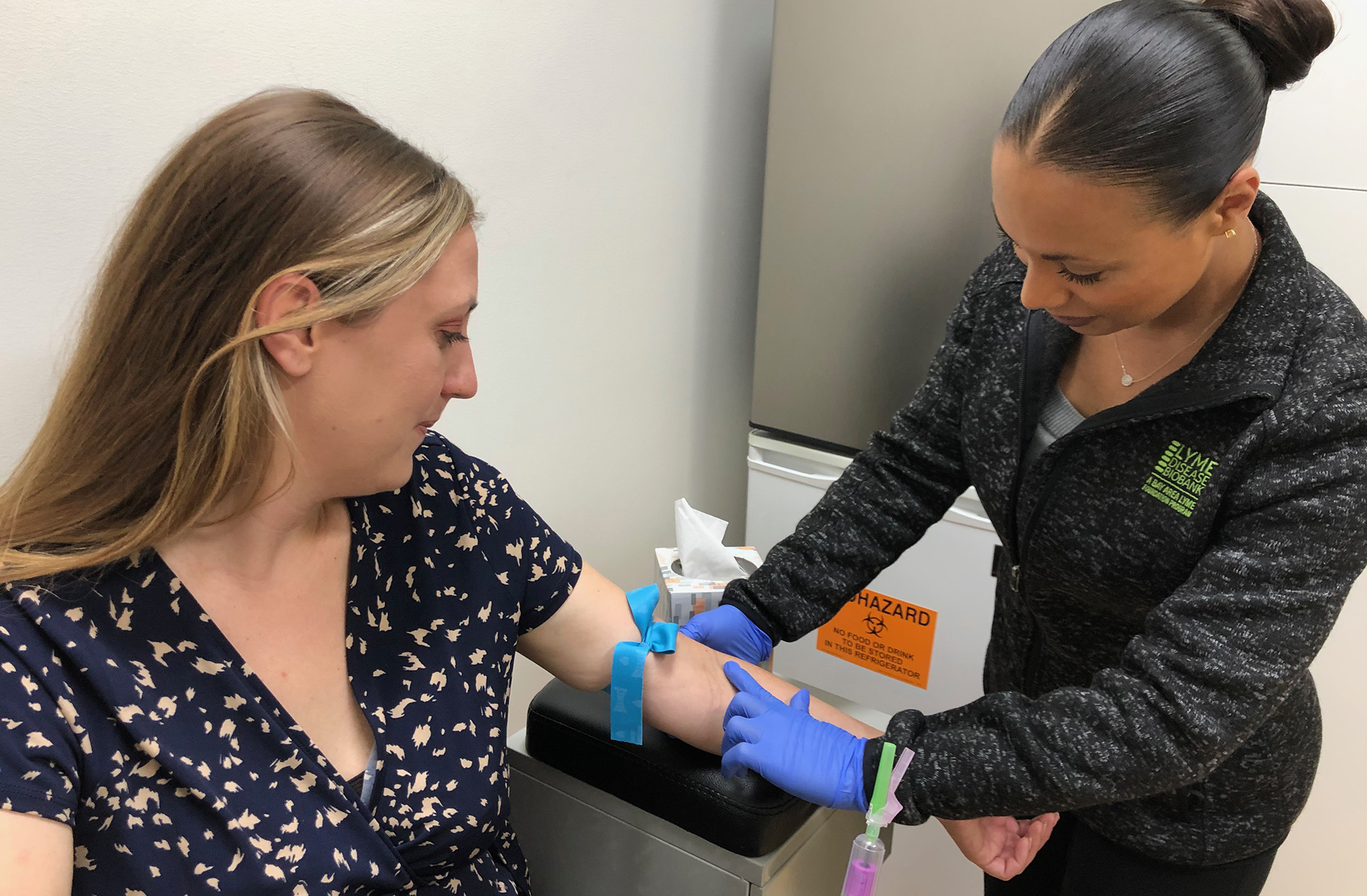
A Lyme disease diagnosis can be overwhelming, and Lyme and tick-borne diseases (TBDs) are complicated. There is a lot of contradictory information available and much to learn. People diagnosed with Lyme or other tick-borne infections (co-infections) can make a difference to help advance research into these complex diseases. The information below is designed to help you determine if you want to contribute blood, urine, or tissue samples to the Lyme Disease Biobank (LDB)—there is no cost to patients or families who participate. If you want to learn more about Lyme and other tick-borne diseases, click here.
There are different ways to donate samples, depending on where you are in your Lyme journey:
Donate Blood and Urine
Lyme Disease Biobank collects blood and urine samples from people with Lyme disease. These samples are made available to approved researchers working on new diagnostics and treatments for Lyme and other tick-borne diseases. A list of collection sites across the US can be found here.
We are currently collecting samples from people with Lyme disease on Eastern Long Island, NY, Central Wisconsin, and the Bay Area, CA. Donors must complete an informed consent form and questionnaire about their medical history prior to donating a sample. For more information about donating an early Lyme sample, click here.
To learn more about the symptoms of Lyme disease, click here.
If you have questions about this program, please email Liz Horn, PhD, MBI, Principal Investigator, Lyme Disease Biobank.
Donate Tissue From Surgeries
Our Lyme Disease Biobank collects human tissue from surgeries such as knee and hip replacements from people with Lyme and other tick-borne diseases. These samples are made available to approved researchers who will look for evidence of infection and evidence of inflammation. Our goal is to better understand how the bacteria that causes Lyme disease and other tick-borne pathogens (bacteria, parasites, and viruses) invade human tissues.
If you are having a surgery in the future, you can donate tissue from the surgery to LDB. The current focus is joint replacements, such as knee, shoulder, and hip replacements. Other surgeries are considered on a case-by-case basis depending on how much tissue will be available.
LDB partners with NDRI (National Disease Research Interchange) to collect human tissue samples. Potential donors register with NDRI and complete authorization forms and questionnaires about their medical history. NDRI will coordinate with the surgery site to collect and transfer the tissue to the LDB repository.
LDB also partners with MyLymeData, the largest Lyme disease patient registry in the world. Tissue donors can choose to link their tissue samples with their MyLymeData profile.
Contact Us
For more information about donating tissue visit NDRI’s Lyme registration page , or call 800-222-NDRI (6374), option 5. If the surgery is occurring within a week, please call the number above for assistance (staff are available 24/7/365). Donating tissue from a surgery is not location dependent. You can plan to do this from anywhere in the continental US.
For general questions that are not time-dependent for surgery, please email Liz Horn, PhD, MBI, Principal Investigator.
Register for Future Organ Donation
Lyme Disease Biobank collects organs and tissues from people with Lyme or other tick-borne diseases at the time of their death (post-mortem). These samples are made available to approved researchers who will look for evidence of infection and evidence of inflammation. Our goal is to better understand how the bacteria that causes Lyme disease and other tick-borne pathogens (bacteria, parasites, and viruses) invade human tissues, including the brain and neurologic tissues.
LDB partners with NDRI (National Disease Research Interchange) to collect human tissue samples. Potential donors register with NDRI and complete authorization forms and questionnaires about their medical history. NDRI will coordinate with the family/next of kin to collect and transfer the tissue to LDB. The post-mortem tissue collection includes neurologic tissue (brain, spinal cord, and nerves), cardiovascular tissue (heart and arteries), musculoskeletal tissue (muscle, cartilage, and synovial membrane), lymph nodes, liver, bladder, and spleen. Cerebral spinal fluid (CSF) and blood are also collected.
LDB also partners with MyLymeData, the largest Lyme disease patient registry in the world. Tissue donors can choose to link their tissue samples with their MyLymeData profile.
Contact Us
For more information about future organ donation visit NDRI’s Lyme registration page, or call 800-222-NDRI (6374), option 5. If the donation may occur within a week or you need immediate assistance, please call the number above (staff are available 24/7/365). You can plan to donate from anywhere in the continental US.
For general questions that are not time-dependent for collection, please email Liz Horn, PhD, MBI, Principal Investigator, Lyme Disease Biobank.

We would like to recognize and thank the Steven & Alexandra Cohen Foundation, the LaureL STEM Fund, and the 2014 & 2018 Fund-a-Need supporters who have contributed significantly to our Lyme Disease Biobank.
Explanations of Frequently Used Terms
What do we mean by acute/early Lyme?
Acute, or “early” Lyme disease symptoms may begin hours, a few days, or even weeks after a bite from an infected tick. This stage is called “acute” because this is the first stage of Lyme disease. Acute Lyme symptoms can overlap with those of other infections, including viruses like influenza and SARS-CoV-2 and other tick-borne infections and may include headache, fever and/or chills, fatigue, muscle and body aches, and joint pain. Lyme disease is often but not always accompanied by an expanding skin rash called an erythema migrans (EM) that develops at the site of the tick bite and sometimes may have a central clearing like a bull’s eye or target. As the bacteria move around the body (disseminate) multiple Lyme rashes and other symptoms (cardiac, neurologic, arthritic) may appear. To read more about acute Lyme symptoms click here.
What do we mean by chronic/persistent Lyme?
When Lyme is diagnosed early and treated with an appropriate course of antibiotics, most people get better. However, for some people, Lyme disease is not diagnosed until later, when the infection has disseminated throughout the body. For others who were diagnosed with early disease and treated, the initial course of antibiotics may not be enough to clear the infection. In both scenarios, people can have ongoing/persistent symptoms of Lyme disease. These chronic/persistent symptoms can include fatigue, sleep impairment, joint pain, muscle pain, other pain, cognitive impairment (including memory issues, burning/stabbing sensations, brain fog), neuropathy (weakness or numbness typically in the hands and feet), or other symptoms. To read more about chronic/persistent Lyme symptoms, click here.
What do we mean by clinical information?
Each sample includes clinical information that tells us more about the person’s experience with Lyme disease and their health history. This clinical information is important for researchers using the samples. Samples are collected at a specific point in time, just like a picture is a snapshot of one point in time. However, life is more like a movie or continuum of pictures, and clinical information helps provide context about the person who donated the sample. This includes if the person recalls a tick bite and their experiences around tick exposure, if they have a rash and what it looks like (a picture is also taken), any symptoms they are experiencing, any antibiotics that are prescribed (or already taken?), if they have a history of Lyme or other tick-borne diseases, information about their general health, and any medications they are currently taking.
What do we mean by “pathogens”?
Pathogens are bacteria, viruses or parasites that can cause disease in humans. When we refer to pathogens, we are talking about all of the different microbes that ticks can pass to humans through bites that cause disease. For example, Lyme disease, the most common tick-borne disease, is usually caused by the bacteria Borrelia burgdorferi, while babesiosis is usually caused by the parasite Babesia microti. Ticks can be infected by multiple pathogens at the same time.
What do we mean by “tissue”?
Tissue is a group of cells with similar structure that act together to perform a specific function. The human body is made up of cells, tissues, and organs. LDB is collecting tissue samples to look for evidence of infection and evidence of inflammation. There are two ways to collect tissue: one is during a planned surgery, and another is after someone has died (post-mortem). For example, tissue such as cartilage can be collected from a knee replacement, while tissues from the brain and heart are usually collected after someone has died. You may find more information in NDRI’s FAQ here.
What do we mean by “well-characterized” samples and why is this important?
LDB samples are described as “well-characterized” because they include clinical information about each donor’s experience with Lyme disease and health history, as well as results from laboratory tests at the time the sample was collected. These tests include tests to measure Lyme antibodies, and tests to detect other tick-borne pathogens the participant might have also been exposed to. Without testing the samples at the time of collection, research results on that sample are harder to interpret. The more information LDB collects on a sample, the more useful it is to approved researchers as they interpret their findings and results.
Is there a cost to participate in Lyme Disease Biobank?
There is no cost to families or patients when donating blood, urine, or tissue.
You may also find comprehensive information about Lyme and other tick-borne diseases here.
We would like to recognize and thank the Steven & Alexandra Cohen Foundation, the LaureL STEM Fund, an anonymous donor, and the 2014 & 2018 LymeAid Fund-a-Need supporters who have contributed significantly to our Lyme Disease Biobank.
We are grateful to the participants who volunteered and donated samples.
